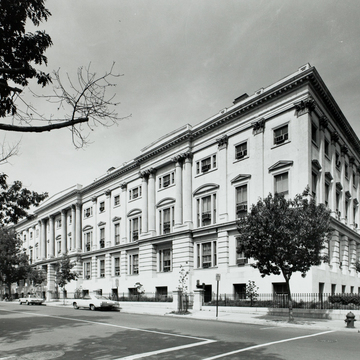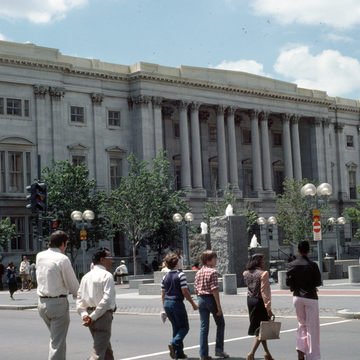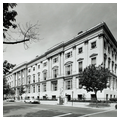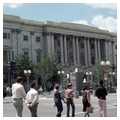You are here
United States Tariff Commission Building (United States General Post Office)
Robert Mills's General Post Office is the least well known of his Washington buildings, yet he and his contemporaries considered it his
Mills's first proposal for the General Post Office was a three-story building with a hexastyle portico raised above an arcaded basement, which in turn was surmounted by a clock tower to be erected either in stone or iron. The actual building is entirely different, based on a traditional Renaissance palazzo, with a rusticated basement below and principal and attic stories knit together by giant Corinthian pilasters. This is the first use of the Italianate style for an important public building in America, although John Notman's Philadelphia Athenaeum (1847) is often accorded that honor.
The main, or south, front has a tetrastyle portico of engaged fluted Corinthian columns framed by single pilasters with narrow pilaster strips on their outside edge, thus making a subtle transition to the wall surface. The center is further emphasized by a tripartite window with a segmental pediment (in contrast to the triangular pediments elsewhere). Three tripartite windows are centered on the east and west facades of the original portion, with the central one framed by a portico of double engaged columns. This subtle layering of the wall surface in conjunction with a complex grid of vertical columns and pilasters, horizontals of basement, a belt course-cum-entablature supporting them, and a cornice and solid parapet at the roofline resulted in Mills's most sophisticated facade, one promoted as a model of additional government buildings planned in the 1840s. It is difficult to appreciate these qualities because the General Post Office has suffered considerably from repeated lowering of the streets. Excavation of its foundations and the subsequent injection of a sub-basement, as well as the loss of an ornate cast-iron fence, have marred its original harmonious appearance.
In 1839 Mills was successful in demonstrating to Congress that repair costs to the Capitol and White House due to the erosion, spalling, and cracking of the Aquia sandstone had been considerable. For the new General Post Office, he was allowed to select a marble if he could find one at a cost comparable to granite, the preferred building material because of its durability. Marble buildings had been erected in Philadelphia and New York, yet none existed in Washington. To celebrate his victory, Mills changed the Corinthian capitals from some unspecified common variety to ones with intertwined volutes between the lateral volutes. The order Mills selected was identified by Palladio as that used on the Temple of Jupiter Stator, the first marble building erected in Rome. Unfortunately the inexpensive Westchester, New York, marble selected was of inferior quality, and both the decorative details and wall surfaces show severe cracking and weathering.
Although Mills employed the same regularized internal plan of a central barrel-vaulted corridor flanked by cubical groin-vaulted offices in his three major Washington office buildings, he created unique entries for each. At the General Post Office, two sets of niches, one outside behind the Doric in antis doorway and the second within the vestibule, create a simple but effective entry sequence of strongly architectonic elements. The vestibule is separated from the corridor by a screen of Tuscan columns, again set in antis. The
With the completion of the General Post Office, Mills had provided for Washington three permanent exemplars of classically derived architecture, each with specific historical references of great importance. His Ionic Treasury was related to the stoa in form, his Doric Patent Office, a temple, and his Corinthian General Post Office was in the form of a palazzo. Their solidity of construction suggests that he was building for eternity; their scale and massiveness suggest an intention of monumentality. It is interesting to note that all three buildings have been in continuous use by the government since they were built and that the rigidity of the grid system of office spaces has not prevented them from being successfully adapted for modern office space.
Walter's addition tripled the length of the east and west facades, created a new northern facade, and introduced subtle changes to the exterior. Projections from his wall surfaces were slightly more three dimensional. The point of juncture can be discerned by his Corinthian capitals, which are more robustly sculptural. Unfortunately, the Maryland marble he employed was not conspicuously superior to the New York marble of the original building. In completing the rectangle, Walter provided an arched opening into the courtyard on the west for the cartage of mail; on the east he imitated Mills's south facade. The sculpture of the keystone and spandrels of the arch was executed by Guido Butti in 1856. Fidelity is in the center, flanked by Electricity, who carries a lightning bolt, and Steam, who holds a steam engine. These allusions were apt. The first telegraphic message (sent over electric lines) was dispatched from this building in 1844 by Samuel F. B. Morse, and railroads, which were rapidly expanding during the 1840s and 1850s, provided for the swift movement of the mails.
Walter's north facade is a very different composition. Here he introduced a major recessed portico formed by four sets of double columns in antis above an arcade, a variation on the portico of the Capitol by Latrobe and Bulfinch. This change in facade treatment presaged a different spatial arrangement on the interior. The city post office was located on the ground floor. Above it was a large, two-story, skylit room with a cast-iron balcony around its perimeter that served as a sorting room for the dead letter office. As in all his additions to Mills's buildings, Walter used iron girders as roof supports, and iron beams to span the halls and offices, which resulted in rectilinear, trabeated spaces rather than vaulted ones. These subtle variations between Mills's and Walter's parts of the General Post Office herald the differences between Neoclassical and Victorian sensibilities in architecture. Availability of better materials and expertise in new building techniques played their part in promoting the change in taste. (Pamela Scott)
Writing Credits
If SAH Archipedia has been useful to you, please consider supporting it.
SAH Archipedia tells the story of the United States through its buildings, landscapes, and cities. This freely available resource empowers the public with authoritative knowledge that deepens their understanding and appreciation of the built environment. But the Society of Architectural Historians, which created SAH Archipedia with University of Virginia Press, needs your support to maintain the high-caliber research, writing, photography, cartography, editing, design, and programming that make SAH Archipedia a trusted online resource available to all who value the history of place, heritage tourism, and learning.




